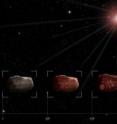Solar wind tans young asteroids
"Asteroids seem to get a 'sun tan' very quickly," says lead author Pierre Vernazza. "But not, as for people, from an overdose of the Sun's ultraviolet radiation, but from the effects of its powerful wind." It has long been known that asteroid surfaces alter in appearance with time — the observed asteroids are much redder than the interior of meteorites found on Earth1 — but the actual processes of this "space weathering" and the timescales involved were controversial.
Thanks to observations of different families of asteroids2 using ESO's New Technology Telescope at La Silla and the Very Large Telescope at Paranal, as well as telescopes in Spain and Hawaii, Vernazza's team have now solved the puzzle.
When two asteroids collide, they create a family of fragments with "fresh" surfaces. The astronomers found that these newly exposed surfaces are quickly altered and change colour in less than a million years — a very short time compared to the age of the Solar System.
"The charged, fast moving particles in the solar wind damage the asteroid's surface at an amazing rate3", says Vernazza. Unlike human skin, which is damaged and aged by repeated overexposure to sunlight, it is, perhaps rather surprisingly, the first moments of exposure (on the timescale considered) — the first million years — that causes most of the aging in asteroids.
By studying different families of asteroids, the team has also shown that an asteroid's surface composition is an important factor in how red its surface can become. After the first million years, the surface "tans" much more slowly. At that stage, the colour depends more on composition than on age. Moreover, the observations reveal that collisions cannot be the main mechanism behind the high proportion of "fresh" surfaces seen among near-Earth asteroids. Instead, these "fresh-looking" surfaces may be the results of planetary encounters, where the tug of a planet has "shaken" the asteroid, exposing unaltered material.
Thanks to these results, astronomers will now be able to understand better how the surface of an asteroid — which often is the only thing we can observe — reflects its history.
Source: ESO
Other sources
- Solar wind found to age asteroid surfacesfrom UPIThu, 23 Apr 2009, 18:35:39 UTC
- Solar wind tans young asteroidsfrom PhysorgWed, 22 Apr 2009, 17:42:44 UTC
